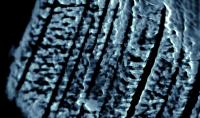New 2D materials under the lens of our researchers
A team from the Faculty of Materials Science and Engineering is examining a new group of two-dimensional materials – MBenes phases. Their unique and still not fully recognized properties may one day be used, among other things, in environmental protection and health care.
Two-dimensional (2D) materials are ultra-thin atomic-thick flakes or layers that are practically translucent to light, and yet extremely durable. One of them is, for example, graphene. Ever since it was discovered, more 2D materials has been searched for.
Agnieszka Jastrzębska, Ph.D., university professor, and her team of researchers from the Warsaw University of Technology are also looking into it.
– The MBenes phases, just like the MXenes, known to us over ten years, are materials of the future – points out Prof. Jastrzębska. – Both of these groups can combine properties that seem contradictory, such as electrical conductivity and perfect hydrophilicity of the surface. They seem similar, but at the same time different. The MXenes phases are the carbides and nitrides of the early transition metals bonded to carbon and/or nitrogen, and the MBenes – to boron atoms.
As a result, unlike the entirely flat MXenes structure, MBenes have a more comprehensive structure, for example a three-dimensional one (3D).
– This indicates that there are numerous possible schemes for the placement of boron atoms at the atomic and elementary cell levels, – explains Prof. Jastrzębska. – This is particularly visible in SEM photographs, in which the edges of the flakes resemble a porous sponge.
This indicates the presence of extremely interesting properties in terms of physical activity (e.g. light adsorption) or chemical activity (reactivity). However, such structure is also a challenge.
– MBenes could be obtained with the method of chemical etching of A-element from the multilayer MAB phase and it would seem that the case is as simple as in the case of obtaining MXenes from the MAX phases – says Prof. Jastrzębska. – Unfortunately, the three-dimensionality of the structure based on boron atoms makes rapid etching difficult or even impossible. Therefore, we are looking for more advanced methods of synthesis and we have already accomplished our first successes in this area.
What are those? Scientists can't reveal that yet. The potential of MBenes phases is not a secret, though.
– The idea of using boron instead of popular carbon and nitrogen creates new opportunities in the field of the material – structure – property relations – says Prof. Jastrzębska. – We expect that the uniqueness and mysteriousness of MBenes phases will enable new discoveries in the chemistry and physics of materials, and thus – exceeding the hitherto unattainable parameters for new functional systems and high-performance materials, e.g. in health care or environmental protection. We also hope to improve the durability of products based on these materials.
The team from the Faculty of Materials Science and Engineering cooperates with many foreign facilities. The cooperation with Prof. Andreas Rosenkranz from the Universidad de Chile, Department of Chemical Engineering, Biotechnology and Materials Science resulted in a publication titled "2D MBenes: A Novel Member in the Flatland" in "Advanced Materials" – one of the most prestigious journals in the world dealing with materials engineering. More information about the research conducted by the team under Prof. Jastrzębska is provided in the article.








